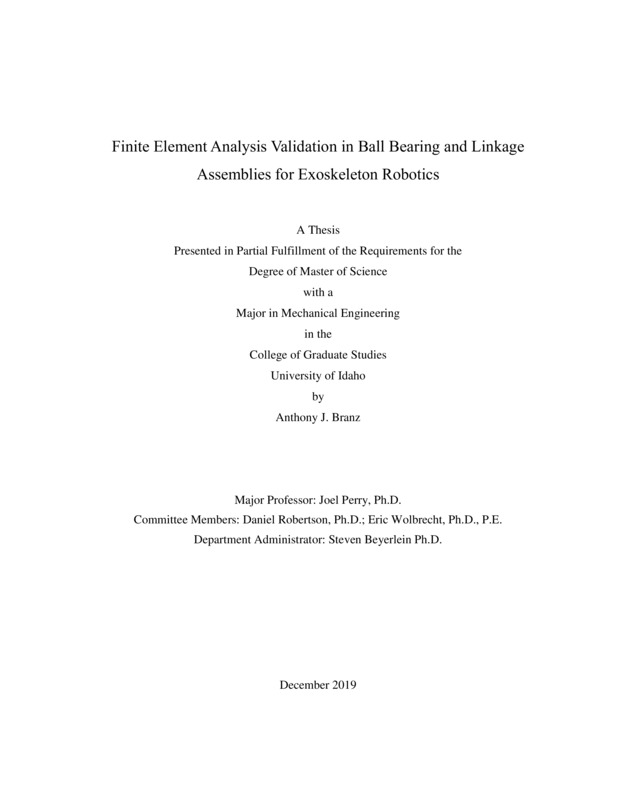Finite Element Analysis Validation in Ball Bearing and Linkage Assemblies for Exoskeleton Robotics
Branz, Anthony John. (2019-12). Finite Element Analysis Validation in Ball Bearing and Linkage Assemblies for Exoskeleton Robotics. Theses and Dissertations Collection, University of Idaho Library Digital Collections. https://www.lib.uidaho.edu/digital/etd/items/branz_idaho_0089n_11781.html
- Title:
- Finite Element Analysis Validation in Ball Bearing and Linkage Assemblies for Exoskeleton Robotics
- Author:
- Branz, Anthony John
- Date:
- 2019-12
- Embargo Remove Date:
- 2022-07-02
- Program:
- Mechanical Engineering
- Subject Category:
- Mechanical engineering
- Abstract:
-
Stroke is one of the leading causes of disability in the world today. Many individuals who have suffered a stroke experience upper-extremity impairment, reducing their quality of life. Studies have suggested that with proper rehabilitation and assessment these individuals can achieve greater recovery, thus improving the lives of many. BLUE SABINO, an exoskeleton being developed at the University of Idaho, is being designed to help assess these stroke patients as well as assist in the rehabilitation process. One of the greatest challenges while designing an exoskeleton is keeping it lightweight while simultaneously ensuring adequate rigidity. Finite element analysis (FEA) is an engineering tool that allows computer models, of structural assemblies/components, to be simulated under specified loading conditions. For structural applications these simulations result in estimates of stresses, strains, and deflections. This tool allows engineers to assess a variety of scenarios rapidly without manufacturing physical components, saving money and time during the design process. However, careful implementation is required to achieve accurate results. This thesis describes three experiments that are compared to their FEA counterparts to check the validity of the solution. One of the assemblies acted as a control test, only featuring bolt connections. The other two assemblies consisted of similar bolt connections while also including multiple bearing connections. The control test was used to find an optimal mesh that kept simulation times low without compromising accuracy and resulted. Comparing the simulation to the experimental data resulted in an error 6.6%. While performing the simulations for the bearing tests, axial and lateral stiffness values could be assigned to the bearings. An optimal value of 3.5e7 N/m (lateral stiffness) and 3.75e5 N/m (axial stiffness) was determined, resulting in solutions with errors of -1.04% and -0.28% at a load of 200N. Using these optimized stiffness values while varying the simulation’s applied load resulted in increased error for both models, with a maximum error of 24.6%. These results show that FEA can be used to accurately predict deflections in bolted and bearing connections used in exoskeletons and provided insight that the bearings were the main source of deflection within the assembly.
- Description:
- masters, M.S., Mechanical Engineering -- University of Idaho - College of Graduate Studies, 2019-12
- Major Professor:
- Perry, Joel
- Committee:
- Wolbrecht, Eric ; Robertson, Daniel
- Defense Date:
- 2019-12
- Identifier:
- Branz_idaho_0089N_11781
- Type:
- Text
- Format Original:
- Format:
- application/pdf
- Rights:
- In Copyright - Educational Use Permitted. For more information, please contact University of Idaho Library Special Collections and Archives Department at libspec@uidaho.edu.
- Standardized Rights:
- http://rightsstatements.org/vocab/InC-EDU/1.0/

